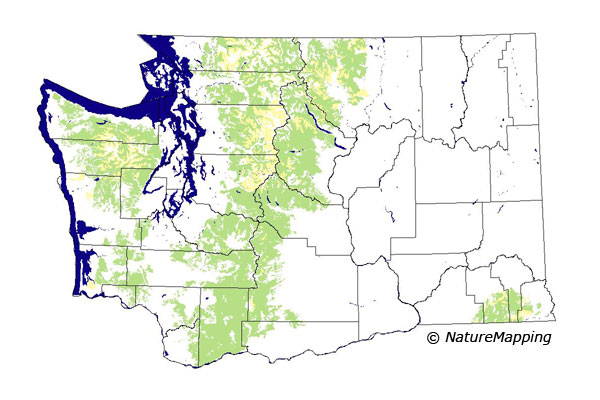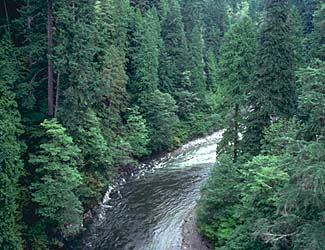 |
Metadata (Data about data or how the map was made)
Legend:
 = Core Habitat
= Core Habitat
 = Marginal Habitat
= Marginal Habitat
Predicted Distribution
Amphibians do not migrate as some birds and mammals, so the colored areas depict
the predicted range for the Tailed Frog year-round. The habitats were identified
using 1991 satellite imagery, other datasets and experts throughout the state,
as part of the Washington Gap Analysis Project.
Distribution and Habitat Requirements
The Tailed frog lives in rocky, cold streams from sea level to 5,000 feet on
both sides of the Cascades and in the Blue Mountains (Leonard et al., 1993;
Metter, 1962). This species is associated with small streams.

|
Models
The Olympic Peninsula, Puget Trough, all of the Cascades and Blue Mountains
ecoregions were selected. Western Hemlock and Silver Fir zones were core
in all of the ecoregions. Otherwise the treatment of zones varied with ecoregion.
Riparian areas were good habitats. Open and closed-canopy, mid- and late-seral
hardwood/conifer forests were considered suitable if adequate microhabitats
were available.
The record locations for the Tailed frog are almost always associated with hilly or mountainous terrain in either cool, wet zones or in zones adjacent to higher cool, wet zones.
Lakes, rivers and riparian areas were good habitats. All open- and closed-canopy hardwood, hardwood/conifer, and conifer forests and all low-density developed residential areas including parks, golf courses, and wooded forests surrounded by development were considered suitable if adequate microhabitats were present.
Other
maps & Information:
|
Webpage designed by Dave Lester.